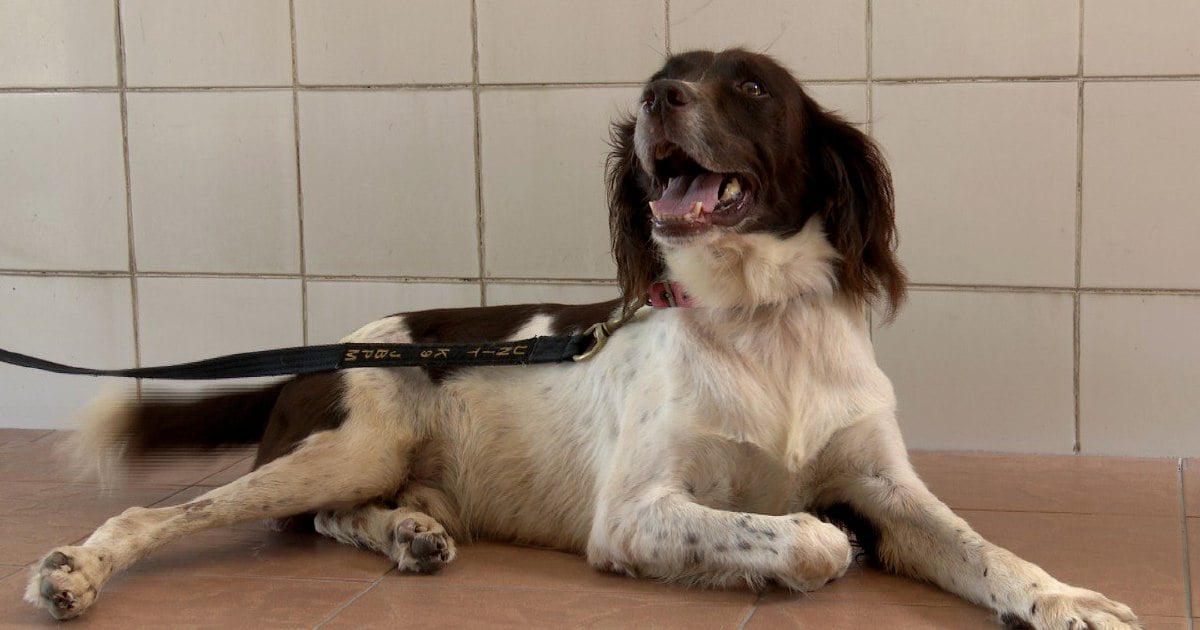WOODY, the black-and-white English Springer Spaniel, has just one motivation. Tail wagging, the seasoned member of the Fire and Rescue Department’s K-9 Unit is expert at sniffing out accelerants in arson investigations.
It’s demanding work, but with his handler, 36-year-old Barnabas Ngelai watching closely, Woody is in his element. To the untrained eye, he may seem to be bounding playfully across the wide-open space.
The 9-year-old dog weaves in a steady zig-zag, nose glued to the ground. Minutes later, he stops, body tense, tail whipping with excitement. Nose still pressed to the spot, he’s found his target. Barnabas raises a hand — the signal of a confirmed find.
There’s no paycheque for Woody — and he couldn’t care less. All he wants is his favourite ball, a good game of fetch and a few belly rubs from Barnabas.
It’s the same story for the 13 dogs in the K-9 Unit here in Kuala Lumpur, with the remaining seven based in Sabah and Sarawak. Most are now “senior citizens” in dog years, but retirement isn’t on the cards for many of them. Out of the 20 dogs, only 15 are still on active duty. The remaining five can’t be deployed due to age or health issues, though they continue to be cared for by the unit.
“It’s a challenge,” admits Mohammed Sallme Jaafar, Senior Fire Superintendent II, who leads the team this morning. “The dogs have to travel long distances when they’re needed, and it does take a toll. Many are older now, so they need more rest in between while working on a case and can’t be overworked.”
It can be a long, difficult trip when the cases are far away or in another state — after all, these dogs serve the entire Peninsular Malaysia. One vehicle usually carries two dogs, with air-conditioning to keep them comfortable, but pit stops are still needed so they can stretch and relieve themselves.
Regardless of the distance or conditions, the dogs and their handlers press on, working as a team to give every mission their best.
It’s a sunny morning at the K-9 Unit in Taman Seri Sentosa, Kuala Lumpur. Team Charlie, made up of 14 handlers, is on duty today, while Teams Alpha and Bravo cover the other two shifts in a three-shift rotation. After a short briefing by Sallme, the handlers head to the kennels, where a chorus of barks greets them.
FURRY FRIENDS
With tails wagging and eyes bright, the dogs can barely contain their excitement as their handlers clip on the leashes and lead them to the nearby outhouse for a quick toilet break.
Most of the time, they rest in their kennels, but twice a day they’re brought out — first at 6:30 am by the previous shift, then again at 9:30 am. Beyond these routines, the dogs get time to socialise with one another or take part in training sessions that keep their skills sharp and their spirits high.
These sessions last between 30 minutes to an hour, depending on the weather. When it gets too hot, the dogs are given shorter workouts before being led back to the kennels to cool down.
Caring for them goes well beyond feeding and exercise. The handlers trim their nails, wipe them down — especially their paws — and make sure every dog is kept clean, healthy and ready for duty. It’s meticulous, hands-on work that reflects the deep bond between each handler and their canine partner.
The bond is real — especially when you see Barnabas, a Sabahan, racing around with a ball, Woody close at his heels. Forget work; it’s playtime now.
“Woody memang seekor anjing yang sangat manja (a very playful and affectionate dog),” he tells me later with a grin. “When he’s in that mood, it’s hard to get him to focus, so I have to manage that side of his personality to get him working.”
Forging that bond takes effort. It means hours spent simply being with the dog. “He might be just a dog, but when you spend time with him, dia akan tahu siapa tuan dia (he’ll know who his master is),” Barnabas explains.
This could be sitting with him during feeding times, talking to him, or grooming him — holding him, asking how he is and speaking as you would to a friend. “That’s when you feel the connection,” he says.
It’s the same connection Sabahan Christer Lasius shares with Frankie, his English Springer Spaniel trained in cadaver detection. Frankie shows his fondness by resting a paw on his handler and giving him a lick. “He can be quite manja also,” says Christer. The black-and-white dog, resembling Woody, is calm and steady. Frankie was among the dogs deployed to the tragic landslide at Father’s Organic Farm in Batang Kali in 2022.
But dogs are not robots. There are days when they’re tired, distracted or simply not in the mood — especially when the weather turns bad.
“Sometimes we need to motivate them by playing an easy game of ‘find’ with the ball,” Christer says with a smile. “After that, they are usually ready to get back to the task at hand!”
“How long can Frankie work?” I ask. “It depends on the weather,” he replies. “If it’s hot, he can only work for about 20 to 25 minutes before needing a half-hour rest, and then he’s ready to go again.”
Frankie sits patiently by the 33-year-old Sabahan’s side. It’s tempting to reach out — because, let’s face it, these dogs are hard to resist.
“You can pet him!” encourages Sallme, watching nearby. The dogs are generally even-tempered — a valuable trait during operations. I reach out and place a tentative hand on Frankie’s head, feeling the softness of his fur as he leans ever so slightly into my touch.
No matter how cute they look or how well they behave, there are no treats for these furry assistants. Their weight is monitored weekly and they are given supplements like fish oil to keep them in peak condition.
According to Sallme, they are fed once a day with food specially formulated to meet their nutritional needs and maintain the stamina required for their physically demanding work.
“Dogs are like humans — they can develop gout, heart problems, kidney issues — so we ensure that their diet is controlled and their health is monitored closely,” he explains.
NO ORDINARY DOGS
Despite their playfulness, these dogs have a serious job to do — one that demands focus, discipline and countless hours of training.
The K-9 Unit, says Sallme, has been part of the nation’s disaster response since 2003. Initially set up in 2002 to strengthen search-and-rescue operations and assist in fire investigations, the unit has grown in both scope and reputation, especially as disasters have become more frequent. In 2018, its reach expanded with the establishment of a K-9 team in Sarawak.
Today, the dogs work across four main disciplines: Urban Disaster Search and Rescue (UDSAR), where they are trained to locate victims in landslides, collapsed structures, and other large-scale disasters; Wilderness, which involves finding people lost in forests or remote terrain; Cadaver Detection, where dogs are trained to detect human remains in post-disaster or criminal investigation scenarios; and Fire Investigation, in which dogs identify the location or source of a fire and detect accelerants that may have been used to start it.
“At the moment, our dogs cover the disciplines of Fire Investigation, Wilderness and Cadaver, but none in UDSAR,” Sallme notes.
The dogs, he insists are vital for many reasons. K-9 dogs — named as a play on the word “canine” — are a vital part of the Fire and Rescue Department’s operations, bringing skills and instincts no technology can match.
With an extraordinary sense of smell, they can sweep large areas in a fraction of the time it would take human teams, pinpointing victims, remains or crucial evidence with remarkable accuracy.
In disaster zones, that speed can mean the difference between life and death — as seen during the 2022 Batang Kali landslide, where Blake and Frankie (English Springer Spaniels) and Denti (a Labrador) helped locate victims. About 50 per cent of those found in the tragedy were discovered with the help of tracker dogs.
In January this year, Lady, a Labrador, and Grouse, an English Springer Spaniel, were sent to Pahang to recover victims of a tragic road accident.
In fire investigations, their precision can reveal clues that might otherwise go unnoticed. Last year, Woody and Jim, both English Springer Spaniels, were deployed to investigate a fire at a shopping mall in Kuala Lumpur. Early this year, Jim — alongside another Springer Spaniel, Sam — were driven all the way to Kedah to investigate a house fire.
For their handlers, these dogs are more than colleagues — they are trusted partners, side by side in some of the most challenging and dangerous situations.
It takes about 15 minutes to prepare the dogs for an operation — deciding which dog to deploy, loading their food and getting them into the vehicle, says Sallme. But the call can come from anywhere in Peninsular Malaysia. “This is the only K-9 unit here right now,” he says. “From Johor to Perlis, we cover it all.”
BLOODLINES AND LEGACY
Considering the work they do, the selection of dogs is equally meticulous. Forget our kampung or Telomian dogs — the K-9s are imported from the United Kingdom for their pedigree and proven history as hunting breeds.
Sallme says the department will soon receive 16 more K-9s, part of a push to boost operational readiness. Director-general Datuk Nor Hisham Mohammad earlier pegged the total cost at RM2.4 million, or RM150,000 per dog including training. The new dogs will be deployed across Peninsular Malaysia as well as Sabah and Sarawak, with each chosen through a meticulous process that prioritises the right breed.
Labradors and English Springer Spaniels, for instance, have been prized for generations for their keen sense of smell, strong work ethic and ability to stay focused in challenging environments — qualities that make them ideal for search, rescue and detection work.
Why not use local dogs? “We haven’t tried,” admits Sallme, “but from what I’ve learnt, they can’t match the capabilities of hunting breeds.”
He says they typically favour medium-breed dogs such as Belgian Malinois, Labrador Retrievers, English Pointers, English Springer Spaniels, and Cocker Spaniels — breeds whose size offers easier manoeuvrability and greater endurance during operations. “Labrador Retrievers are one of the best,” he insists.
Each fully trained dog comes with certificates and X-rays to verify its bloodline, pedigree and health. Training is carried out both overseas and locally to ensure that the dogs are equipped with the skills and conditioning needed for their specialised roles. What’s equally crucial, Sallme shares, is ensuring the dogs’ temperament matches well with the local handler. “Otherwise, it won’t work,” he says.
Bonding is everything. For both Barnabas and Christer, that connection with their dogs runs deep. Frankie is Christer’s second partner; his first was Tiny, a Labrador Retriever he handled for six years.
“He listened to all my commands. When I said ‘sit,’ he’d sit. When I said ‘down,’ he’d go down. When I said ‘come,’ he’d come. His specialty was Urban Disaster,” Christer recalls.
But Tiny eventually fell ill. “We took him to the vet and he was treated, but it was hard to see him so unwell and unable to get up. We cared for him until the very end,” he says quietly.
For these dogs, retirement means staying with the unit until the very end. They work for as long as they are able, and when they can no longer do the job, Sallme says, they remain under the unit’s care for the rest of their lives. “If they no longer have a good quality of life, then we have to euthanise them,” he shares, adding: “But that decision is always weighed very carefully.
In the meantime, they serve faithfully for as long as they can.
Later, Paula the English Pointer is put to the test. The wilderness-trained dog takes a deep sniff of a handler’s cloth, nose twitching as she locks onto the scent. The moment she’s released, Paula takes off with single-minded focus. In less than a minute, she’s found the man hiding nearby, standing alert beside him until her handler arrives.
It’s an impressive display, a clear reminder of the skill and dedication these dogs bring to every mission.
From the moment they are selected, they spend their lives in training, honing instincts passed down through generations. They work without question, driven not by medals or recognition, but by the bond they share with their handlers and the job they were born to do.
And their reward? A ball, a game of fetch and a few belly rubs — simple pleasures for a job well done.
© New Straits Times Press (M) Bhd






